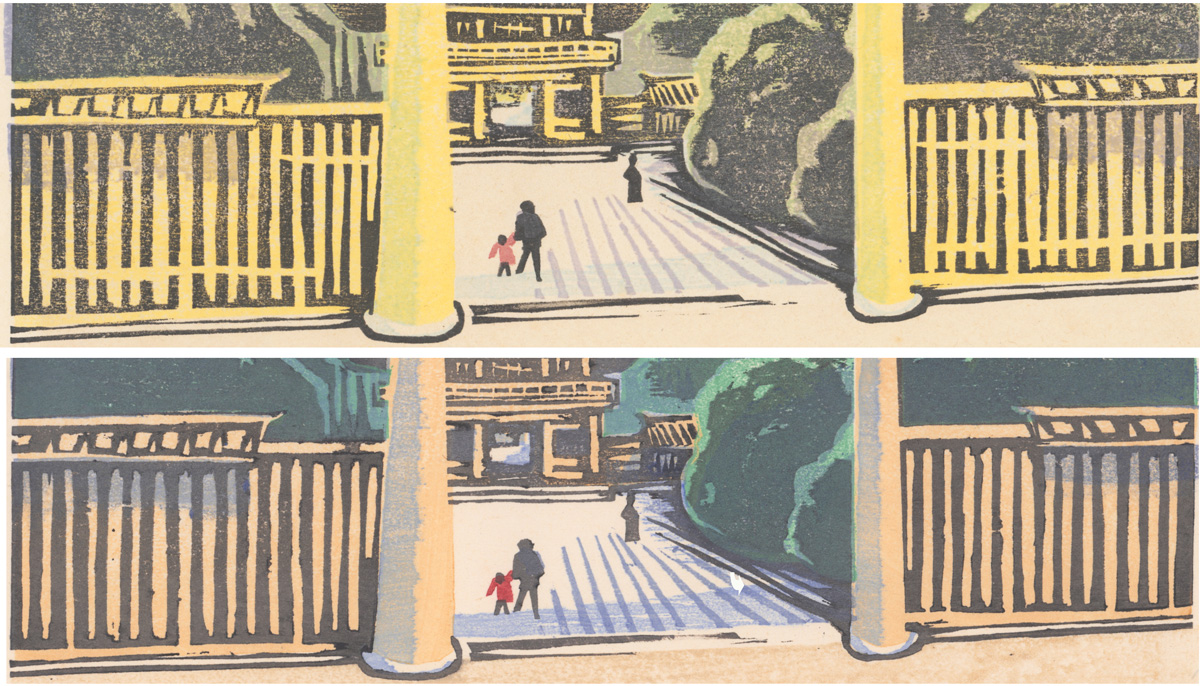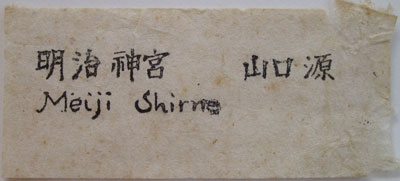Souce: Japanese Prints During the Allied Occupation 1945 – 1952, Lawrence Smith, The British Museum Press, 2002, p.24
This print is one of fifteen from the 1945 series Scenes of Last Tokyo (Tokyo kaiko zue) and one of seven new designs created for this series. Smith points out that six of the prints in this series depicted "places with serious imperial resonances," the six being the Nijubashi Bridge at the Imperial Palace, the Akasaka Palace (residence of the Crown Prince), the Meiji Shrine, the Torii (Gateway) at Kudan, the Gate of the Imperial University (alma mater of the most senior bureaucrats of the militarist era), and the Graveyard of Sengaku-ji, burial place of Japan’s most celebrated paragons of loyalty.
This collection's two impressions of this print, while likely printed from the same blocks, with possibly some reworking of the blocks in between printings, display several notable differences, the most obvious being the absence of the horizontal members on the fence adjoining the tori in IHL Cat. #1854. Of the dozen or so impressions of this print I've seen IHL Cat. #1854 is the only one without the horizontal elements of the fence.
Exhibition Wall Label from ”Japanese Prints: Edo/Tokyo”
Yamaguchi Gen’s print memorializes a place destroyed by American bombing, the Meiji Shrine, originally dedicated in 1920 and reopened in 1958. The shrine was built on the site of the Yoyogi Imperial Gardens, formerly the Ii Daimyo estate, enjoyed as a refuge by the Meiji Emperor and Empress. The gigantic torii gate to the complex was constructed of concrete rather than the more common wood, showing a newly favored material in the Meiji era, as Japan strove to modernize and Westernize. Meiji Shrine in the 1930s became a symbol of the Emperor’s authority and nationalistic pride. Simplification of the surroundings indicates that this is a post-bombing memory of what had once existed.
Source: Japanese Prints During the Allied Occupation 1945-1952, Lawrence Smith, British Museum Press, 2003, p. 58.
In this series, which takes a nostalgic look at a Tokyo then largely destroyed or seriously damaged, several places associated with State Shinto and the Imperial Family are picturesquely and innocuously depicted in an apparent attempt to rehabilitate them. The Meiji Shrine in Akasaka was dedicated to the Emperor Meiji (reigned 1868-1912), who was grandfather of the then reigning emperor. It had been completed only in 1926, so was by no means an old monument in 1945. Yamaguchi shows the place as a haven of peace. The design is one of the few entirely new ones for this portfolio.
This print is one of fifteen from the 1945 series Scenes of Last Tokyo (Tokyo kaiko zue) and one of seven new designs created for this series. Smith points out that six of the prints in this series depicted "places with serious imperial resonances," the six being the Nijubashi Bridge at the Imperial Palace, the Akasaka Palace (residence of the Crown Prince), the Meiji Shrine, the Torii (Gateway) at Kudan, the Gate of the Imperial University (alma mater of the most senior bureaucrats of the militarist era), and the Graveyard of Sengaku-ji, burial place of Japan’s most celebrated paragons of loyalty.
This collection's two impressions of this print, while likely printed from the same blocks, with possibly some reworking of the blocks in between printings, display several notable differences, the most obvious being the absence of the horizontal members on the fence adjoining the tori in IHL Cat. #1854. Of the dozen or so impressions of this print I've seen IHL Cat. #1854 is the only one without the horizontal elements of the fence.
Memorializing the Meiji Shrine
Source: Los Angeles County Museum of Art website http://collectionsonline.lacma.org/mwebcgi/mweb.exe?request=record;id=104182;type=101Exhibition Wall Label from ”Japanese Prints: Edo/Tokyo”
Yamaguchi Gen’s print memorializes a place destroyed by American bombing, the Meiji Shrine, originally dedicated in 1920 and reopened in 1958. The shrine was built on the site of the Yoyogi Imperial Gardens, formerly the Ii Daimyo estate, enjoyed as a refuge by the Meiji Emperor and Empress. The gigantic torii gate to the complex was constructed of concrete rather than the more common wood, showing a newly favored material in the Meiji era, as Japan strove to modernize and Westernize. Meiji Shrine in the 1930s became a symbol of the Emperor’s authority and nationalistic pride. Simplification of the surroundings indicates that this is a post-bombing memory of what had once existed.
Source: Japanese Prints During the Allied Occupation 1945-1952, Lawrence Smith, British Museum Press, 2003, p. 58.
In this series, which takes a nostalgic look at a Tokyo then largely destroyed or seriously damaged, several places associated with State Shinto and the Imperial Family are picturesquely and innocuously depicted in an apparent attempt to rehabilitate them. The Meiji Shrine in Akasaka was dedicated to the Emperor Meiji (reigned 1868-1912), who was grandfather of the then reigning emperor. It had been completed only in 1926, so was by no means an old monument in 1945. Yamaguchi shows the place as a haven of peace. The design is one of the few entirely new ones for this portfolio.
明治神宮 山口源
Print Details
| IHL Catalog | #121 and #1854 |
| Title | Meiji Shrine (Meiji Jingu) |
| Series | Scenes of Last Tokyo [also seen translated as Recollections of Tokyo] 東京回顧図会 Tokyo kaiko zue |
| Artist | Yamaguchi Gen (1896-1976) |
| Signature | unsigned |
| Seal |  |
| Publication Date | December 1945 |
| Edition | unknown |
| Publisher | Fugaku Shuppansha 富岳出版社, Tokyo, Uemura Masurō 上村益郎 publisher |
| Printer | Hirai Kōichi 平井孝一 |
| Impression | IHL Cat. #121: excellent IHL Cat. #1854: excellent |
| Colors | IHL Cat. #121: good IHL Cat. #1854: excellent |
| Condition | IHL Cat. #121 :good - random printers ink in left margin; slight browning on lower left and right margins; several foxing spots in image and margin; tape remnants on corners of top margin verso from previous mounting in original non-archival presentation folder IHL Cat. #1854: excellent - still tipped into original presentation folder |
| Genre | sosaku hanga (creative print) |
| Miscellaneous | |
| Format | horizontal chuban |
| H x W Paper | IHL Cat. #121: 7 15/16 x 11 in. (20.2 x 27.9 cm) IHL Cat. #1854: 7 13/16 x 10 15/16 in. (19.8 x 27.8 cm) |
| H x W Image | IHL Cat. #121: 7 1/8 x 9 9/19 in. (18.1 x 24.3 cm) IHL Cat. #1854: 7 1/16 x 9 1/2 (17.9 x 24.1) |
| Collections This Print | Los Angeles County Museum of Art M. M.81.267.27 and .29; Carnegie Museum of Art 89.28.709.14; Mead Art Museum at Amherst College AC 2008.63.3; British Museum 1980.12-27.018(C3); Mead Art Museum at Amherst College 2008.63.3; Smithsonian Freer Gallery of Art and Arthur M. Sackler Gallery S1995.118.7; Portland Art Museum 1996.31.2c; Art Institute Chicago 1990.337.3 |
| Reference Literature | The Artist's Touch, The Craftsman's Hand: Three Centuries of Japanese Prints from the Portland Art Museum, Maribeth Graybill, Portland Art Museum, Oregon, 2011, p. 296; Made in Japan: The Postwar Creative Print Movement, Alicia Volk, Milwaukee Art Museum, 2005, p. 35; Japanese Prints During the Allied Occupation 1945-1952, Lawrence Smith, British Museum Press, 2003, figure 41; Modern Japanese Prints: The Twentieth Century, Amanda T. Zehnder, Carnegie Museum of Art, 2009, p. 182. |






